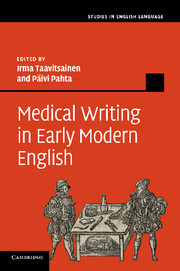Book contents
- Frontmatter
- Contents
- List of plates
- List of figures
- List of tables
- Notes on contributors
- Preface
- List of abbreviations
- 1 An interdisciplinary approach to medical writing in Early Modern English
- 2 Medical texts in 1500–1700 and the corpus of Early Modern English Medical Texts
- 3 Medical literacies and medical culture in early modern England
- 4 Verbs of knowing: discursive practices in early modern vernacular medicine
- 5 Defining in Early Modern English medical texts
- 6 Dissemination and appropriation of medical knowledge: humoral theory in Early Modern English medical writing and lay texts
- 7 Code-switching in Early Modern English medical writing
- 8 New arguments for new audiences: a corpus-based analysis of interpersonal strategies in Early Modern English medical recipes
- 9 Efficacy phrases in Early Modern English medical recipes
- 10 Medical pamphlets: controversy and advertising
- 11 The development of specialized discourse in the Philosophical Transactions
- 12 The expression of stance in early (1665–1712) publications of the Philosophical Transactions and other contemporary medical prose: innovations in a pioneering discourse
- Appendix A Raw data tables corresponding to Figures 4.3–4.14
- Appendix B Raw data tables corresponding to Figures 8.1–8.4
- Appendix C Stance markers used in the analysis in Chapter 12
- Appendix D Preliminary list of texts in the corpus of Early Modern English Medical Texts (EMEMT)
- Bibliography
- Index
12 - The expression of stance in early (1665–1712) publications of the Philosophical Transactions and other contemporary medical prose: innovations in a pioneering discourse
Published online by Cambridge University Press: 03 May 2011
- Frontmatter
- Contents
- List of plates
- List of figures
- List of tables
- Notes on contributors
- Preface
- List of abbreviations
- 1 An interdisciplinary approach to medical writing in Early Modern English
- 2 Medical texts in 1500–1700 and the corpus of Early Modern English Medical Texts
- 3 Medical literacies and medical culture in early modern England
- 4 Verbs of knowing: discursive practices in early modern vernacular medicine
- 5 Defining in Early Modern English medical texts
- 6 Dissemination and appropriation of medical knowledge: humoral theory in Early Modern English medical writing and lay texts
- 7 Code-switching in Early Modern English medical writing
- 8 New arguments for new audiences: a corpus-based analysis of interpersonal strategies in Early Modern English medical recipes
- 9 Efficacy phrases in Early Modern English medical recipes
- 10 Medical pamphlets: controversy and advertising
- 11 The development of specialized discourse in the Philosophical Transactions
- 12 The expression of stance in early (1665–1712) publications of the Philosophical Transactions and other contemporary medical prose: innovations in a pioneering discourse
- Appendix A Raw data tables corresponding to Figures 4.3–4.14
- Appendix B Raw data tables corresponding to Figures 8.1–8.4
- Appendix C Stance markers used in the analysis in Chapter 12
- Appendix D Preliminary list of texts in the corpus of Early Modern English Medical Texts (EMEMT)
- Bibliography
- Index
Summary
Introduction
Language users, regardless of register, employ a variety of lexico-grammatical markers to express their attitudes towards, evaluations of and level of commitment to what they speak or write. The linguistic marking of attitudes and assessments has been investigated under a variety of labels, such as evaluation (Hunston 1994; Hunston and Thompson 2000), hedging and boosting (Hyland 1996, 1998), evidentiality (Chafe 1986) and, perhaps most widely, stance (e.g., Biber 2004a, 2006; Biber and Finegan 1988, 1989; Biber et al. 1999; Hyland 2005; Precht 2003). Stance research has investigated stance markers in a variety of registers and includes detailed investigations of particular stance devices (e.g., Lindemann and Mauranen's 2001 investigation into ‘just’), studies on a class of items (e.g., Swales and Burke 2003 on evaluative adjectives) and studies that document the ways in which multiple grammatical and semantic classes of stance features interact (e.g., Biber 2004a, 2006).
In spite of once-held perceptions that academic writing is largely free of overt markers of the writer's attitudes and opinions, recent scholarship has demonstrated that stance is an important aspect of formal written prose. This scholarship has emphasized the role of stance in creating and maintaining relationships between the writer and his or her audience as well as reflecting the value system of writers and their discourse communities (Hyland 1999, 2001, 2002; Thompson and Hunston 2000).
- Type
- Chapter
- Information
- Medical Writing in Early Modern English , pp. 221 - 247Publisher: Cambridge University PressPrint publication year: 2011
- 17
- Cited by



